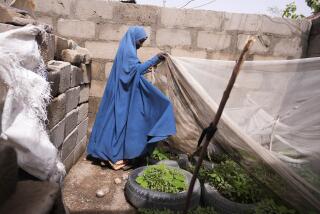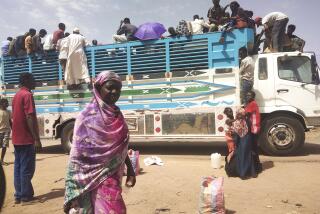Children starve in parched southern Madagascar
- Share via
Reporting from Anjandobo, Madagascar — Foreigners have come to Anjandobo village, a cluster of wooden huts on the desolate red dust of southern Madagascar. They’re vaza -- outsiders.
The vaza are sweating. They wear hats and carry cameras and plastic bottles of water.
The sun exhausts the vaza: four journalists and a group of aid workers from UNICEF and the World Food Program. Scorpions bristle under rocks. There’s little shade.
A small Anjandobo child watches the vaza with their water bottles.
“I’m thirsty.”
“No water,” replies the child’s mother.
Her younger toddler chimes in. “I want to drink water.”
“No water,” the mother repeats, matter-of-fact.
Madagascar’s rainfall has decreased 10% in the last 50 years, and its temperature has risen 10%.
-- The World Bank
The spiny forest that once grew everywhere is a memory not much mourned here. It was a tangle of spectacular triffid-like trees with reaching, spiky arms, full of thorns and terrible creatures such as owls, snakes and lemurs.
Here, snakes are bad spirits that strangle children. Eyes popping, an old man named Valiotake clamps his hands on his throat, making dramatic choking noises, miming a child being attacked by a snake. He hoots loudly, mimicking the call of an owl, which heralds death. Lemurs aren’t lucky either.
Valiotake, 85, is the oldest man in Anjamahavelo. He founded his village with his brother in 1971 and helped to name it “At the Lucky Baobab,” after a common tree on the island. Like many people in the area, he has one name. His face is as dry and cracked as the bottom of a dry riverbed.
“I sacrificed a big fat sheep. I hoped we’d flourish and grow.”
The second thing, after the sacrifice, was to slash and burn every bit of greenery. It took only a day.
And the wood made good houses.
Madagascar has lost 90% of its forests.
-- The World Wildlife Fund;
the World Bank
Sometimes people from international aid organizations come to tell the villagers that cutting down trees means less rain. Valiotake listens politely. He knows about the droughts, the crop failures. But he has no inkling of the great forces that are also baking his land to desert: global warming.
In his heart, he doesn’t think it’s because of cutting down the trees.
“I think the big God is unhappy. Young people are killing each other for nothing. They don’t respect the taboos. It never happened in the old days.”
In three of the last five years, southern Madagascar has seen crop failures because of drought.
-- The World Food Program
Sometimes, the vaza build wells, like the one in Anjamahavelo. But it hasn’t worked in years. In Anjandobo, the World Food Program has been paying people in food to build a concrete basin to collect rain in the next wet season. Outside nearby Ifotaka village there’s another vaza project, by the World Wildlife Fund: plantings of the spiky succulent called Alluau-dia procera, lined up in rows like an invading army of aliens.
The journalists and aid workers crowd into a mean triangle of shade and ask the villagers questions about the reforestation project.
“What benefit does this bring your people?” asks a journalist, extending a microphone.
“Well, we’re not getting paid for it,” says Remanaitse, 76, a village leader, puzzled. “We have to do it. Because you foreigners tell us to do it. So we do it.”
In the driest regions in southern Madagascar, 1.5 million people have inadequate food because of prolonged drought -- 250,000 of them children younger than 5.
-- The World Food Program
In Ifotaka, children with ragged clothes and protruding bellies trudge the dirt tracks herding cows or carting water. Women walk with children on their backs.
Some mothers walk up to 30 miles carrying their starving babies to get to the Ifotaka health center. Many arrive too late.
At the center, a woman named Sambeie waits with her baby, 7-month-old Maka Mahazoasy, who is being treated for acute malnutrition. The nurses have told her some foreign journalists are coming to see her.
She waits under a tree. Hours pass. By the time the vaza arrive, Maka can’t be settled. He cries and struggles and is hot. She has no milk to calm him with.
The vaza have many questions. She tells them: Three of her 12 children died.
“We don’t grow anything, because there’s no rain. My children are always hungry and they complain. I feel so sad that there’s nothing to give them. I also starved as a child, but it’s much worse now. There’s no rain, because it’s God’s will.”
At the end she asks the vaza, “Was it interesting?” They say yes, and thank her.
“You have to know that my son is starving,” she replies, with finality.
Maka has a respiratory infection, simple to cure, but a killer. She doesn’t want to take him to the hospital and leave eight children at home.
A Malagasy aid worker is given the job of persuading her, in private. She begins: “Do you love this child?” -- “Yes, more than any of them,” Sambeie replies.
More than 8,600 children have been treated for malnutrition in southern Madagascar in the last six months because of drought and crop failure, more than double the number expected.
-- UNICEF
The old man, Valiotake, amazingly, still has dreams for his village, even though it has the feel of a place about to disappear. He thinks the place named after a lucky tree will grow huge. One day there’ll be a clinic.
He will sacrifice a sheep in December, a thin one, because all the animals are thin, like his people.
He’ll kill the sheep to ask the big God for rain.
At the hospital in distant Amboasary town, the wards darken as the sun sinks. Maka is quiet, peaceful. Sambeie spoons in medicated formula. His life seems a victory over fate, but there are so many others.
On the wall is a faded paper graph, a count of dead and starving children. International aid organizations also count the dead and write reports full of statistics: 81,500 children younger than 5 die annually; 53% of children that age are chronically malnourished; 44.2% live in extreme poverty and hunger.
But it’s only here in the hospital, and in the parched villages, that the numbers seem real.
One in a series of occasional articles about the effects of climate change on people’s lives around the world.
More to Read
Sign up for Essential California
The most important California stories and recommendations in your inbox every morning.
You may occasionally receive promotional content from the Los Angeles Times.










